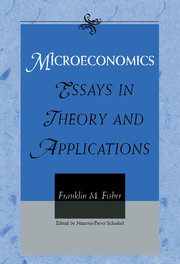Book contents
- Frontmatter
- Contents
- Introduction
- Part I Disequilibrium and Stability
- Part II Welfare Economics and Consumer Theory
- Part III Applications of Microeconomic Theory
- 19 On Donor Sovereignty and United Charities (1977)
- 20 A Proposal for the Distribution Abroad of the United States' Food Surplus (1962)
- 21 A Theoretical Analysis of the Impact of Food Surplus Disposal on Agricultural Production in Recipient Countries (1963)
- 22 US Experience: The Recent INS Study (1970)
- 23 Aspects of Cost-Benefit Analysis in Defence Manpower Planning (1969)
- Part IV Industrial Organization, Economics, and the Law
- Part V Public Policy Applications
- Epilogue
- Indexes
23 - Aspects of Cost-Benefit Analysis in Defence Manpower Planning (1969)
Published online by Cambridge University Press: 20 March 2010
- Frontmatter
- Contents
- Introduction
- Part I Disequilibrium and Stability
- Part II Welfare Economics and Consumer Theory
- Part III Applications of Microeconomic Theory
- 19 On Donor Sovereignty and United Charities (1977)
- 20 A Proposal for the Distribution Abroad of the United States' Food Surplus (1962)
- 21 A Theoretical Analysis of the Impact of Food Surplus Disposal on Agricultural Production in Recipient Countries (1963)
- 22 US Experience: The Recent INS Study (1970)
- 23 Aspects of Cost-Benefit Analysis in Defence Manpower Planning (1969)
- Part IV Industrial Organization, Economics, and the Law
- Part V Public Policy Applications
- Epilogue
- Indexes
Summary
Introduction
Cost-benefit (or cost-effectiveness) analysis has become in recent years a rapidly developing and highly fashionable tool in defence and other governmental operations. This is as it should be. Such analysis can be an invaluable aid to systematic and rational decision making in complex situations. Yet the proper application of cost-benefit analysis requires more than just the use of the appropriate words. Complicated questions are likely to require sophisticated analysis, and proper use of the techniques of cost-benefit analysis requires detailed attention to the very hard problems that arise in particular cases. It may be all too easy to pass over such problems with a relatively perfunctory treatment, believing that one cost-benefit analysis is much the same as another.
In the present paper, I shall discuss some of the hard problems that arise in cost-benefit analysis, particularly in defence manpower planning. Some of these problems have no easy solution in practice, and the analyst may have to get along with approximate or makeshift solutions. All these problems, however, must be faced as matters for conscious decision if a proper analysis with valid and useful answers is to be performed. While it may turn out in particular cases that some problems can be set aside, this cannot be assumed ab initio and careful attention rather than unconscious choice must be exercised.
The problems that I shall discuss do not form an exhaustive list of those that arise, nor can I give entirely satisfactory solutions to all of them. Indeed, in some cases I can do little more than call attention to the need for further analysis.
- Type
- Chapter
- Information
- MicroeconomicsEssays in Theory and Applications, pp. 325 - 358Publisher: Cambridge University PressPrint publication year: 1999



